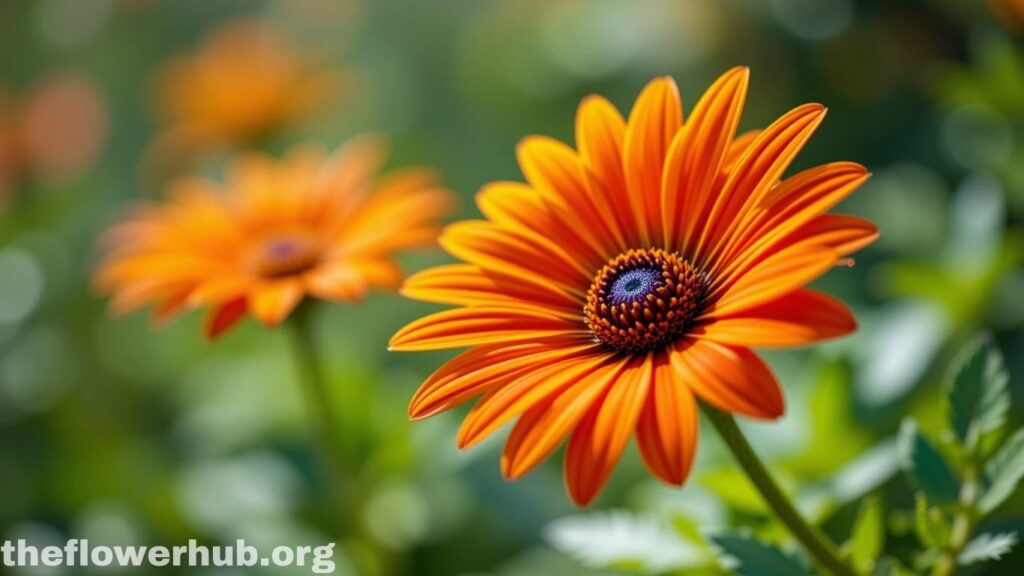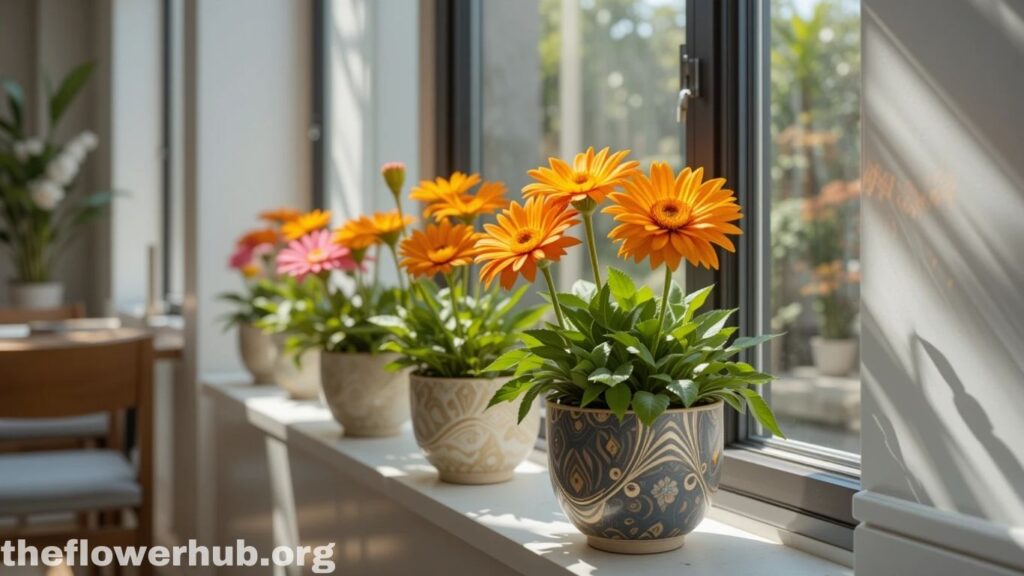The Gazania flower, AKA the “Treasure Flower,” is a bright and cheerful sun-worshipper that’s sure to brighten the heart of any gardener. This spectacular bloom is native to South Africa and is known for being tough as nails and for its amazing ability to bloom in harsh conditions. Whether you have been gardening for years or you’re just starting, Gazania flower is a beautiful, simple flower to grow.
In this comprehensive guide, we’ll cover the gazania flower from all angles — from where it originated and the different types of gazanias (varieties), to how gazania is grown, what it’s used for commercially, and its symbolism. Read on to see 7 amazing Gazania flower facts that will increase your love for this undervalued beauty.

Table of Contents
Table: Quick Overview
| Feature | Description |
|---|---|
| Botanical Name | Gazania rigens |
| Common Names | Treasure Flower, African Daisy |
| Family | Asteraceae |
| Origin | South Africa |
| Color | Orange, Yellow, Pink, Red, White, Bicolor |
| Blooming Season | Spring to early fall |
| Sun Requirements | Full sun |
| Watering | Low (drought-tolerant once established) |
| Soil Type | Well-drained, sandy soil |
| Life cycle | Annual or perennial (depending on location) |
| Pollinators Attracted | Bees, Butterflies, Insects |
| Symbolism | Joy, Cheerfulness, Resilience |
The Gazania Flower – Origins and Meanings
The Gazania flower is actually named after Theodorus of Gaza, a Greek scholar who is known for his translations of botanical manuscripts and the scientists’ community award named after him. This plant is indigenous to South Africa and is a member of the daisy family that likes arid, sunny places.
Gazania’s South African Roots
In the wild, the Gazania flower grows in the dry and rocky plains as well as the shores. It has survived harsh conditions and has emerged as a symbol of tough and resiliency.
Cultural and Symbolic Value
The gazania is known for it cheerful or lively attitude, full of vibrant color and tends to bloom in the sunny areas of your garden. In the language of flowers, used by the Victorians to show feelings through gifts, it represents cheerfulness and optimism.
Varietes of Gazaniana and their Wonderful Colours.
There are a wide variety of cultivars and hybrids that this daisy comes in all shapes and colors. The choices are seemingly endless, from single colors to patterned petals.
Popular Gazania Varieties:
- Gazania rigens – This is the most common species with large daisy-like flowers.
- Gazania ‘Kiss Orange Flame’ – Bright orange petals with dark centers.
- Gazania ‘New Day Mix’ – Colorful options ranging from yellow to pink.
- Gazania ‘Big Kiss White Flame’ – Big white blooms with fiery centres.
- Gazania ‘Talent Mix’ – Silver foliage with multi-colored flowers.
Gazania flowers are popular for decorative landscaping, borders, pots, and hanging baskets due to their bright colour range.
Growing Conditions: How to Cultivate Gazania Flowers Successfully
The gazania flower is very low on the maintenence scale and therefore is one of the most popular choices for novice gardeners and xeriscaping initiatives.
Ideal Conditions for Growth:
- Sunlight: Full sun (at least 6-8 hours of day time).
- Soil: Prefers well-drained, sandy soil.
- Irrigation: Moderate to low. Drought-tolerant once established.
- Spacing: 6 to 9 inches apart for solid coverage.
- Fertilization: Fertilize lightly in the growth seasons with balanced fertilizer.
Propagation
Gazania Flower Propagation You can propagate gazanias:
- Seeds (most common and economical)
- Varieties (for when hybrids are treated so that quantities are the same)
Seeds from gazanias sprout in about 7-14 days and bloom in 12-14 weeks with proper care.
Commercial and Contemporary Uses
Besides ornamental purposes, the gazania flower is also used in landscaping and environmentalism.
Landscaping
- Groundcover: It’s a spreader so is great for erosion control.
- Roadside Beautification: Because it is tolerant of heat and poor soil, the gazania is used to edge roads and walkways.
- Commercial gardens and parks: It has very long blooming season and needs less maintenance.
Ecological Benefits
- Pollinator Appeal: Flowers attract bees, butterflies and beneficial insects.
- Purify The Air: They also purify and refresh the air by releasing oxygen.
Retail
- Seed propagated 350-400 seeds/oz., 3 oz./100′, 9 oz./1,000′, 15 lb./acre at 15 seeds/ft., in rows 18″ apart.
Gazania Flower in Interior Planting and Pots
The gazania flower doesn’t stay outdoors, either. Brimming in pots, containers, and window boxes, too.

Tips for Indoor Gazania:
- For the maximum amount of sunlight, use a south-facing window.
- Make sure the soil drains well and don’t overwater.
- Regularly remove faded flowers to prompt new growth.
Diminutive size and bright blooms are why the gazania flower is so popular with apartment dwellers and indoor gardeners.
Scientific Research and Medicinal Insights
Gazania flowers are strictly ornamental plants, but have drawn attention in botanical studies recently.
Studies Have Shown:
- Phytochemistry: Some species of Asteraceae family have antioxidant and antimicrobial properties.
- Though the gazania flower itself isn’t used for many medicinal purposes, related plants have promise for pharmaceutical purposes.
Note: Gazania is not considered a major medicinal plant at present however its family Asteraceae hosts numerous medicinal plants.
Taking care of your gazania flower: seasonal maintenance advice
Despite being very hardy, the gazania flower can benefit from care to maximize blooming and lifespan.
Seasonal Care Guide:
- Spring: Plant seeds or seedlings outside after the last frost; fertilize gently.
- Summer: Deadhead often, water minimally and check for pests.
- Autumn: Herbal and seed production – remove dead flowers and let seed heads dry out for propagation.
- Winter: Treat as an annual or bring indoors in colder climates.
FAQs
Q1: Can I plant gazania flowers in containers?
Yes, the gazania flower does well in container gardens with excellent drainage and full sun!
Q2: Is gazania perennial or annual flower?
They are warm climate tender perennials and in cold areas are used as annuals.
Q3: How often do I need to water my gazania plants?
Water sparingly. Once established, gazania flowers are drought-resistant plants that like dry soil.
Q4: Are gazania flowers attractive to bees and butterflies?
Indeed, their bright colors and nectar-rich flowers have a pollinator appeal.
Q5: Is gazania a flower that can grow indoors?
Yes, if they get direct sun for most of the day, and are in soil that drains well.
Q6: How to Deadhead Gazanias?
Deadhead by pinching or snipping the spent flowers just above the foliage to promote continued blooming.
Q7: Are gazania poisonous to dogs, cats or horses?
Safety of gazania to cats and dogs This plant is probably not toxic to pets, although it might be better to avoid ingestion of the plant in large amounts.
Conclusion
The Gazania flower is more than a pretty flower. With low maintenance requirements, and a range of bold colours and how it can be applied, it is an essential for anyone gardening casually or professionally. Whether you’re edging a driveway, lighting up a balcony or just want a pollinator-friendly array of blossoms, gazania provides a hardy, exuberant and colorful solution.
Drought Tolerant Blooms The gazania flower is also a value-added rock garden star in the news as climate change pressures traditional gardening practices. It’s nature’s beauty and strength in a single eco-friendly tree; a tree rooted in unproductive soil and the hot sun.
And if you haven’t already, maybe add the gazania flower to your garden palette — it’s a small stride toward a more colorful, sustainable and joyous green space.
